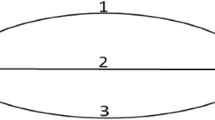Abatract
Improving transportation system is essential for all people in each city since transport plays a very important role. Using mathematical programming approach transport problem is an effective way to improve transportation system. In this paper, the traffic equilibrium problem (TEP) with a general nonadditive route cost function is studied. We formulate the route cost function for each route as a disutility function, which can evaluate route cost function flexibly and analyze the route toll conveniently. Furthermore, we present the TEP with a nonlinear complementary problem (NCP) formulation. The monotonicity and the existence with the NCP formulation are also given under relative assumptions.
Similar content being viewed by others
References
Tang T Q, Hang H J. Continuum models for freeways with two lanes and numerical tests. Chinese Sci Bull, 2004, 49: 2097–2104
Sun X Y, Wang B H, Yang H X, et al. Effects of information feedback on an asymmetrical two-route scenario. Chinese Sci Bull, 2009, 54: 3211–3214
Dai J C, Li X. Multi-agent system for simulating traffic behaviors. Chinese Sci Bull, 2010, 55: 293–300
Sheffi Y. Urban Transportation Networks: Equilibrium Analysis with Mathematical Programming Methods. New Jersey: Prentice Hall, 1985
Patriksson M. The Traffic Assignment Problem: Models and Methods. Utrecht: VSP, 1994
Boyce D, Xiong C. Forecasting travel for very large cities: challenges and opportunities for China. Transportmetrica, 2007, 3: 1–19
Wong S C, Yang C, Lo H K. A path based traffic assignment algorithm using the TRANSYT traffic model. Transp Res Part B, 2001, 35: 163–181
Tian Q, Yang H, Huang, H J. Novel travel cost functions based on morning peak commuting equilibrium. Op Res Lett, 2010, 38: 195–200
Gabriel S A, Bernstein D. The traffic equilibrium problem with nonadditive path costs. Transp Sci, 1997, 31: 337–348
Larsson T, Lindberg P O, Lundgren J, et al. On traffic equilibrium models with a nonlinear time/money relation. In: Patriksson M, Labbe M, eds. Transportation Planning—State of the Art. Boston: Kluwer Academic Publishers, 2002. 19–31
Agdeppa R P, Yamashita N, Fukushima M. The traffic equilibrium problem with nonadditive costs and its monotone mixed complementarity problem formulation. Transp Res Part B, 2007, 41: 862–874
Aashtiani H. The multi-modal traffic assignment problem. Doctoral Thesis. Operations Research Center. Cambridge, MA: MIT Press, 1979
Aashtiani H, Magnanti T. Equilibrium on a congested transportation network. SIAM J Alg Discrete Meth, 1981, 42: 213–226
Facchinei F, Pang J S. Finite Dimensional Variational Inequalities and Complementarity Problems. New York: Springer-Verlag, 2003
Author information
Authors and Affiliations
Corresponding author
Rights and permissions
About this article
Cite this article
Xu, M., Gao, Z. A complementary formulation for traffic equilibrium problem with a new nonadditive route cost. Sci. China Technol. Sci. 54, 2525–2530 (2011). https://doi.org/10.1007/s11431-011-4484-z
Received:
Accepted:
Published:
Issue Date:
DOI: https://doi.org/10.1007/s11431-011-4484-z




